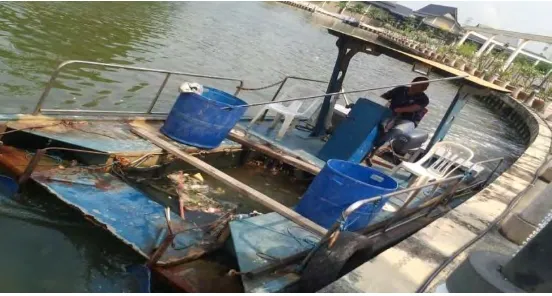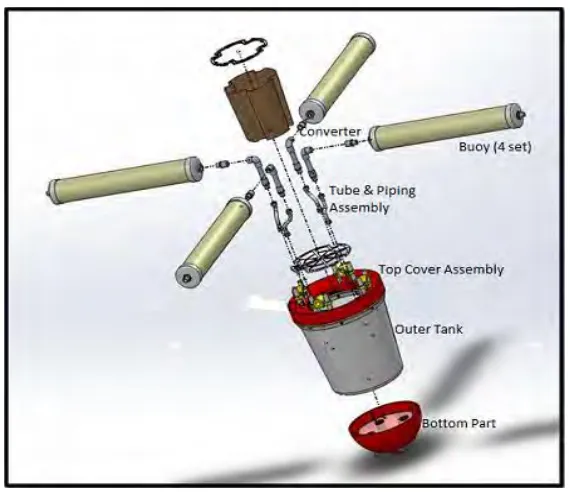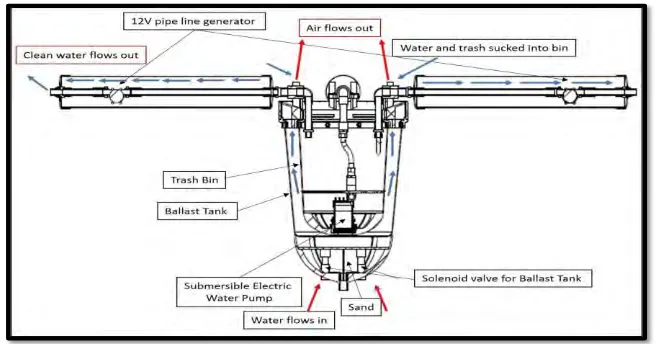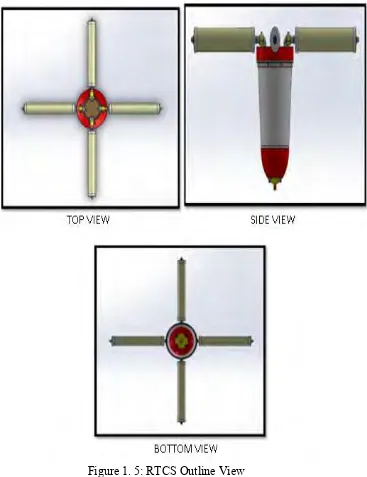1
UNIVERSITI TEKNIKAL MALAYSIA MELAKA
OPTIMIZATION OF RTCS MAIN FRAME BY USING
NUMERICAL METHOD
This report is submitted in accordance with the requirement of the Universiti Teknikal Malaysia Melaka (UTeM) for the Bachelor of Mechanical Engineering
Technology ( Automotive Technology) with Honours.
AZHARUDIN BIN AHMAD B071410628
760611-04-5307
2
(Mengandungi maklumat TERHAD yang telah ditentukan oleh organisasi/badan di mana penyelidikan dijalankan)
UNIVERSITI TEKNIKAL MALAYSIA MELAKA
BORANG PENGESAHAN STATUS LAPORAN PROJEK SARJANA MUDA
TAJUK: Optimization Of RTCS Main Frame By Using Numerical Method
SESI PENGAJIAN: 2017/18 Semester 1
Saya AZHARUDIN BIN AHMAD
Mengaku membenarkan Laporan PSM ini disimpan di Perpustakaan Universiti Teknikal Malaysia Melaka (UTeM) dengan syarat-syarat kegunaan seperti berikut:
1. Laporan PSM adalah hak milik Universiti Teknikal Malaysia Melaka dan penulis. 2. Perpustakaan Universiti Teknikal Malaysia Melaka dibenarkan membuat salinan
untuk tujuan pengajian sahaja dengan izin penulis.
3. Perpustakaan dibenarkan membuat salinan laporan PSM ini sebagai bahan pertukaran antara institusi pengajian tinggi.
4. **Sila tandakan ( )
SULIT
TERHAD
TIDAK TERHAD
(Mengandungi maklumat yang berdarjah keselamatan atau kepentingan Malaysia sebagaimana yang termaktub dalam AKTA RAHSIA RASMI 1972)
(TANDATANGAN PENULIS)
AlamatTetap:
44-1, Batu 12, Kampung Lanjut Manis
Krubong, 75250
Melaka.
Tarikh: _14 December 2017_________
Disahkan oleh:
(TANDATANGAN PENYELIA)
Cop Rasmi:
Tarikh: _______________________
i
DECLARATION
I hereby, declared this report entitled “Optimization of RTCS Main Frame by Using Numerical Method” is the results of my own research except as cited in references.
Signature : ……….
ii
APPROVAL
This report is submitted to the Faculty of Engineering Technology of UTeM as a partial fulfillment of the requirements for the degree of Bachelor of Mechanical Engineering Technology (Automotive Technology) with Honours. The member of the supervisory is as follow:
iii
ABSTRAK
iv
v
ABSTRACT
vi
DEDICATION
To my beloved parents,
Jamilah bt Roslan, Nur Ainin Sofiya bt Azharudin, Nur Ainin Athirah bt Azharudin and Muhammad Daniyal Wafiey bin Azharudin.
Thank you for all support, sacrifices, patient and willingness to share with me.
To my honoured supervisor and co supervisor,
Encik Mohd Idain Fahmy Rosley, Encik Mohd Fariduddin Mukhtar, and All UTeM lecturers.
vii
ACKNOWLEDGEMENT
All praise belongs to ALLAH (SWT). Without the health, strength and perseverance He gave, I would not be able to complete this project thesis. I have taken efforts in this project and spend time wisely to complete this thesis. However, it would have not been possible without the kind support and help of many individuals. In
particular, I want to thank to anyone that contributed in my project thesis. They have encouraged me and giving full though during this project. First, I would like to express the deepest appreciations to my supervisor Encik Mohd Idain Fahmy Bin Rosley for his patient and endless supports that continually teaching me throughout my project. He gave me a necessary suggestions and constant supervision as well as for providing information regarding the project thesis. Without this guidance and persistent help this project thesis would not complete successfully. Besides that, I would like to thank to my co supervisor Encik Mohd Fariduddin Bin Mukhtar who introduced me to this project and he gave me an inspiration idea about the project. He also provides me an opportunity to cooperate with him on designing a project. By spending his valuable time, he shared his knowledge with his full attentions in carrying out this project thesis. I also want to express my gratitude towards my beloved parents and families for their kind motivate on to go through all the hard works and they gave me their supports and positive vibes while carrying out this project. In addition, I am very grateful for those giving me a chance to ask
vii i
TABLE OF CONTENT
DECLARATION i
APPROVAL ii
ABSTRAK iii
ABSTRACT v
DEDICATION vi
ACKNOWLEDGEMENT vii
TABLE OF CONTENT viii
LIST OF TABLES xi
TABLE OF FIGURES xii
LIST OF ABBREVIATIONS, SYMBOLS AND NOMENCLATURE xiv
CHAPTER 1 1
INTRODUCTION 1
1.0 Research Background 1
1.1 Problem Statement 6
1.2 Research Objectives 7
1.3 Scope o fthe Research 7
1.4 Significance of Research 7
CHAPTER2 9
LITERATURE REVIEW 9
2.0 Introduction 9
2.1 Main Frame work for River Trash Collector System (RTCS) 9 2.2 Principle of Design and Stress Analysis 10
2.3 Material 11
2.4 Stress 11
2.5 Design Factors 13
2.6 Optimization 13
ix
2.8 Anti Corrosion Material 17
2.9 Solidworks Software 20
2.10 Solid Thinking Software 22
2.11 Conclusion: 23
CHAPTER 3 24
METHODOLOGY 24
3.0 Introduction 24
3.1 Operational Framework 25
3.2 Design Pocess Flow 26
3.3 SolidWorksSoftwareApplication 26
3.4 Solid Thinking Software Application 27
3.5 RapidPrototyping Application 28
3.6 Welding 29
3.7 Product Design Concept (PDC) 29
3.8 Concept SelectionMethod 32
3.9 Conclusion 33
CHAPTER 4 34
RESULT & DISCUSSION 34
4.0 Introduction 34
4.1 Concept Selection of Main Framework for RTCS 34 4.2 Design of Main Framework for River Trash Collector System 36 4.3 Topology Optimization Main Framework for River Trash Collector
System (RTCS) to minimize mass. 37
4.4 Final Decision 44
4.4 Result of Analysis After Redesign Process 45
x
CHAPTER 5 53
CONCLUSION & FUTURE WORK 53
5.0 Introduction 53
5.1 Challenges of the Project 53
5.2 Recommendations 54
5.3 Conclusion 55
REFERENCES 56
xi
LIST OF TABLES
Table 2. 1: Comparison of CAE software 22
Table 3. 1: Example of Decision Matrices 32
Table 3. 2: Example of Concept Screening Matrix 33
Table 3. 3: Example of Concept Scoring 33
Table 4.1: Main Framework for RTCS Concept Screening Matrix 34
Table 4.2: Main Frame of Buoy Mechanism Concept Scoring
Matrix 35
xii
TABLE OF FIGURES
Figure 1. 1:Trash Collector Boat 2
Figure 1. 2:Prototype of River Trash Collector System (RTCS) 3
Figure 1.3: Cross Sectional of River Trash Collector System
(RTCS) 4
Figure 1.4: Water Orientation of River Trash Collector System
(RTCS) 4
Figure 1.5: RTCS Outline View 5
Figure 2.1: Design A 14
Figure 2.2: Design B 14
Figure 2.3: Design C 15
Figure 2.4: Design D 16
Figure 3.1: Operational Framework Flow Chart 25
Figure 3.2: Design Process Flowchart 26
Figure 3.3: Basic Process of Solid Thinking 27
Figure 3.4: Basic Process of Rapid Prototyping 28
Figure 3.5: Design A 29
Figure 3.6: Design B 30
Figure 3. 7: Design C 31
Figure 4.1: Initial Isometric View Structural Main Framework for
RTCS 36
Figure 4.2: Initial design and overall weight Main Framework for
xii i Figure 4.3: Design space with constraint or support involved 38
Figure 4.4: Contact position for each part 38
Figure4.5: Slider cursor to determines how much quantity of
material used 39
Figure 4.6: The setting that involved in Topology Optimization 40
Figure 4.7: Main Framework for RTCS Assembly 41
Figure 4.8: Isometric View Main Framework for RTCS 41
Figure 4.9:Front, Side and Bottom View Main Framework for
RTCS 42
Figure 4.10:The comparison result of topology optimization that
being held on the Main Framework for RTCS. 43
Figure 4.11:Result of topology optimization converted to solid
part using Solidworks 44
Figure4.12:Figure 4.14: Analysis of Displacement (optimization) 45
Figure 4.13: Analysis of Factor of Safety (optimization) 46
Figure 4.14: Analysis of Percent of Yield (optimization) 47
Figure 4.15: Max shear stress analysis 48
Figure 4.16:Von Mises Stress analysis 49
xi v
1
LIST OF ABBREVIATIONS, SYMBOLS AND
NOMENCLATURE
RTCS – River Trash Collector System PVC – Polyvinyl Chloride
1
CHAPTER 1
INTRODUCTION
1.0 Research Background
The Malacca River which flows through the middle of Malacca City in the
Malaysian state of Malacca was a vital trade route during the heyday of Malacca
Sultanate in the 15th century. The river starts from the foothills in the neighboring
state of Negeri Sembilan and feeds into the Straits of Malacca. Malacca River is now
better known as a tourist and recreation. There are boat rides along the river Melaka to see events around the state run by PPPSM. Moreover PPPSM also were responsible to ensure the cleanliness and beauty of the river Melaka maintained that continues to attract tourists.
A USD$100 million (RM350 million) infrastructure project to revive and rejuvenate the river which is the central to Malacca as an historic city was carried out. This has included construction of a tidal barrage, restoration of buildings and bridges, dredging, concrete river banks with river walkways. Land reclamation projects have extended the river mouth further into the Straits.(De Witt 2010)
In recent year, to tidy up the Malacca River, water will be discharge once it water level tallness achieved 7 meters. Generally the water will be discharge amid 2-3am consistently as this is high tide period. At that point, they let sea water into the river and close the entryway to give the river a chance to water blend with sea water. The
mixing methodology of sea water expels smell of river brought on by natural matter
found in waterway. By then, the water will be released to the sea through the gate of
the river between Malacca Waterway and ocean. At that point, the water will be
2 with the rubbish that has accumulated in the dam. A research by Li in (2009), a major barrier to water pollution forecasting is the absence of a proficient system for water pollution checking. Customary water pollution examining is tedious, costly, and must be taken for little sizes. Water pollution has turned into a wellspring of human disease. On the other hand, water which sustains human has ended up undetectable killer of humankind. Besides that, there has a lot of trash in the water. Trash float at water level, permitting ocean water bound with trash, oil, and cleansers persistently to spill into it. Thus, water pollution is about amounts of polluting substance discharged and how enormous a volume of water is released. A little amount of a harmful synthetic may have little effect on the off chance that it is spilled into the sea from a boat. Be that as it may, the same measure of the same synthetic can have a much greater effect pumped into a lake or river, where there is less perfect water to disperse it.
(Kean Hua & Ping 2016) also indicated that utilization of strategy in controlling and dealing with the water assets in Malacca River can be effectively actualizes. Be that as it may, the arrangement will take a long haul to actualize. Furthermore, the Malacca River that loaded with refuse and plastics bottles in the past is currently being spotless utilizing trash collector boat which is changed by them. This cleaning boat has a gap with a net in front to trap the garbage into it. This procedure just needs one watercraft driver and another gatherer. The gatherer is mindful to gather the huge waste into the receptacle to anticipate blockage. The garbage will be gathered once per day, and every procedure just takes around 3 hours for the entire river. This garbage authority vessel made the procedure of gather trash simple and quick if contrast with last time. Figure 1.1 below shows the trash collector boat in operation system.
[image:18.596.202.478.588.736.2]
3 The River Trash Collector System (RTCS) is one option available to solve pollution at Malacca River was invented by Nurhidayah binti Hanizat as student degree Bachelor of Manufacturing Engineering Technology. In order to solve water pollution cases, River Trash Collector System (RTCS) is designed based on several concept ideas and suggestion f material to be used. The general idea comes from Sea bin concept which acts as a trash collector in sea area. But, there a several improvements necessarily in River Trash Collector System (RTCS) especially, floating mechanisms also important to make sure the River Trash Collector System(RTCS) has an efficiency to float by using buoy system and ballast tank concept. Figure 1.2 below shows the River Trash Collector System (RTCS) concept in operation system.
4 4
1.0 River Trash Collector System (RTCS)
[image:20.596.157.485.115.287.2]
Figure 1. 3: Cross Sectional of River Trash Collector System (RTCS) The process of River Trash Collector System (RTCS) is as follows:
i. Water flows in at the bottom side when the water pump functions by using power source such as water turbine generator and solar panel. ii. Trashes will flow in at the top side of the bin and trapped at the trash
bin inside. Then, clean water flows out by passing through the four corners buoy system.
iii. Air in the water flows out from the River Trash Collector System (RTCS).
Figure below shows the water orientation for River Trash Collector System (RTCS)
[image:20.596.217.432.547.679.2]
5 5 1.0.2 Outline of RTCS View
[image:21.596.153.520.201.678.2]These are outline of RTCS from the past review. A few perspectives of configuration are given to translate the detailed outline. The outline of RTCS is as per the following:
Figure 1. 5: RTCS Outline View
6 6 1.1 Problem Statement
River Trash Collector System (RTCS) has a floating mechanism in their concept to make sure that trash collector can float in the water area. A connector having a floating structure in corporate a floating holder for coupling segment associated with a compact electrical contraption to a base through a drifting instrument. The floating holder is shaped of plastic as a different part from a connector fundamental body that gave the fitting coupling segment. The coasting holder has a first holder and a second holder for squeezing and supporting a coupling deck of the connect or principle body from inverse sides. The principal holder and the second holder have locking snares and are coupled to each other specifically or through the connector fundamental body. Also, the principal holder and the second holder have necessarily shaped bolster parts for supporting the coupling deck of the connector primary body. So, it can connect all the sides off floating mechanism for River Trash Collector System (RTCS).
However, there are improvements to be made to existing forms to be customized according to the needs and problems faced. The problem that has been encountered is as follows:
i. Constraints of space to put RTCS due to the small width of the Malacca river cause RTCS difficult to put in suitable areas to avoid being hit when the boat odds. Movement and disputes between the boats also produced strong waves that can cause RTCS budge and functions affected.
ii. The ability to cope with the burden of body-connection between the float and the body made of PVC breakable because they could not support the weight of the body.
iii. Float shape and size causes the body not being able to sink that affect the function of RTCS.
iv. Aesthetic concept which a float made of PVC cylinder seems less aesthetic to impress people.
7 7 1.2 Research Objectives
The objectives of this research were as follows:
i. To generate a new concept design main frame for River Trash Collector System (RTCS) using Solid works software.
ii. To optimized the selected concept main frame for River Trash Collector System (RTCS) using Solid Thinking software.
iii. To redesign the optimized result conceptual main frame of buoyancy mechanism for River Trash Collector (RTCS) using Solid works software.
1.3 Scope of the Research
The aim of this project is study produce some of main frame drawing for RTCS by sketching. Concept Selection Method is used to selected the model that can fulfill the criteria. The selected model concept will then be redesigned into 3D drawing using solid work software. The model drawings were subsequently optimized using Solid-Thinking software to obtain an aesthetic and less weight. After that, the drawings will be redrawn to get appropriate form using solid works software. Then, prototype will produce by Selective Laser Sintering machine. The resulting concept idea will be used in the future for RTCS development.
1.4 Significance of Research



